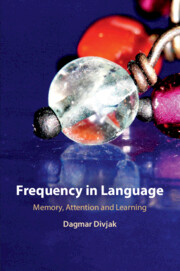7 - Salience: Capturing Attention in and through Language
from Part III
Published online by Cambridge University Press: 26 September 2019
Summary
Attention tends to be paid to items that are ‘just right’ in terms of information richness, not the most frequent ones, and not the rarest ones. But what is ‘just right’? What captures our attention? As explained in the previous chapter, attention can be attracted by stimulus properties (such as loudness or brightness) or by the organism’s goals (e.g., stimuli that signal events of biological significance, which aids survival). For example, Mackintosh (1975) claims that organisms will pay attention to, and hence readily learn about, stimuli that are good predictors of important events (such as food or pain). Thus, stimuli with high associative strength, in particular stimuli that have a higher predictive value than all other stimuli present, receive most attention. Pearce and Hall (1980) proposed that controlled attention will be directed to those stimuli that need to be learned about; how much learning needs to be done is determined by the surprisingness of the event that follows.
- Type
- Chapter
- Information
- Frequency in LanguageMemory, Attention and Learning, pp. 182 - 202Publisher: Cambridge University PressPrint publication year: 2019



